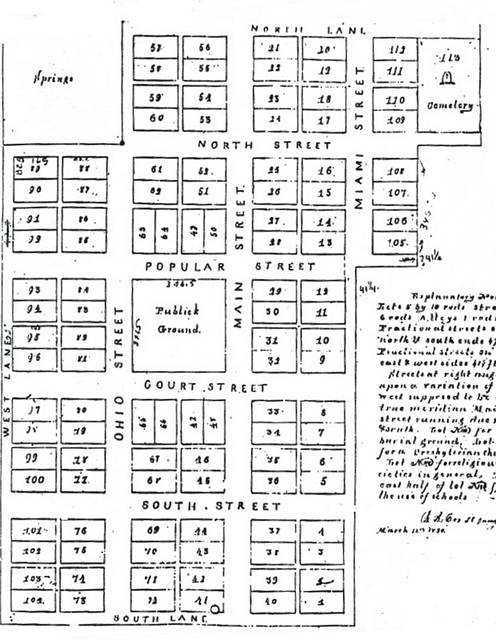
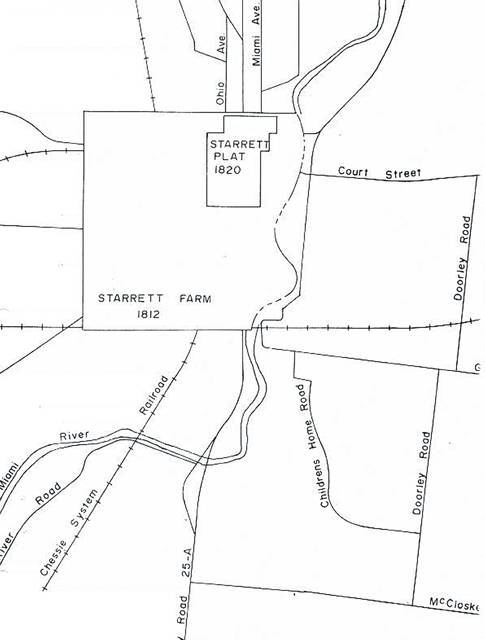
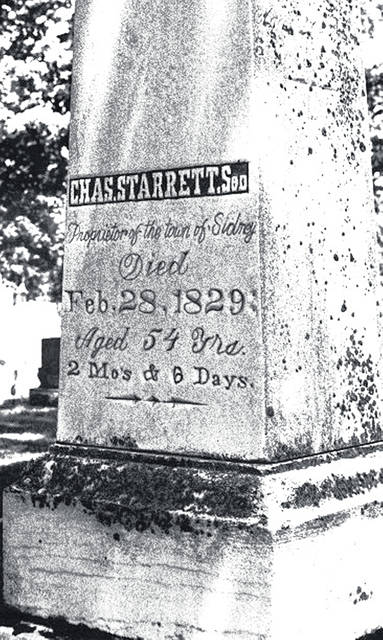
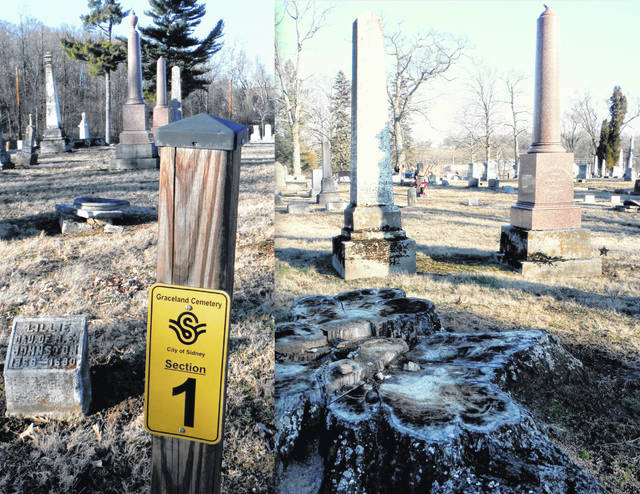
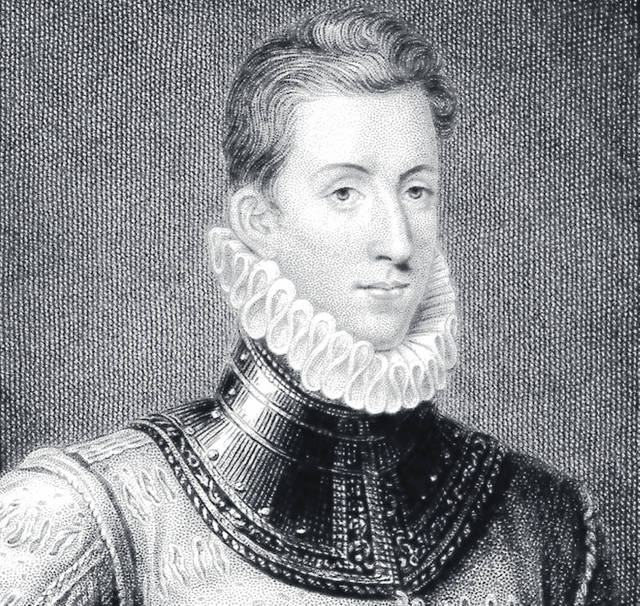

Editor’s note: in conjunction with the 200th anniversary celebration of the establishment of the city of Sidney, the Sidney Daily News will be publishing a year long series about the city’s history.
SIDNEY – Nestled against the Great Miami River, Sidney’s original plat was part of 508 acres purchased by Irish immigrant Charles Starrett in 1809.
The transaction was completed in 1812 with a government land patent made out to Charles Sterrett, paying approximately $1.25 per acre. Born in Ireland in 1774, he had originally lived in Virginia and Pennsylvania before coming to Ohio.
Not much is known about Starrett, however, the first record of him here is in Champaign County where, on April 19, 1810, he married Nancy Reed. Upon the death of his father, Charles and his siblings each were bequeathed 100 pounds whereby he then purchased the large tract of land issued to him on Oct. 5, 1812, via a land patent (S36, T8, R6) by President James Madison.
The late William A. Ross, Jr. discovered in Charles’ estate settlement … “A May 26, 1818 letter from John Todd, Executor of the Estate of Charles Starrett’s father acknowledging that there was one hundred pounds (entered as $333.33) willed to said Charles by his father.”
The wills of Charles’ parents, Robert and Elizabeth Starrett, written in Virginia, eventually were found in Kentucky and confirmed that their second child was Charles Starrett, of Sidney, Ohio. Documents reviewed over the years include numerous spellings of the Starrett surname, Sterrit, Sterrit, Sterrett, Starret, Starrett, etc.
In 1819, Starrett donated 70 acres for the sole purpose of starting a town. Early accounts refer to the area as Starrett’s town, which later became known as Sidney, named in honor of Sir Philip Sidney, an English knight.
Starrett’s original homestead was located near Starrett’s Run, (in the vicinity of what was Klipstine Lumber), at 231 S. Walnut Ave. in Sidney. It was demolished circa 1924. Charles and his wife, Nancy, were the parents of three children, Elizabeth, James and Robert. Elizabeth died unmarried at 24, James’ only child did not survive, and Robert died unmarried at the age of 20. Starrett passed at the age of 54 on Feb. 28, 1829.
Sidney, the county seat
Sidney was incorporated as a village in 1820, as a town in 1834 and received a charter in 1897. It was recorded on Sept. 24, 1819, “I, the undersigned subscriber, proprietor of fraction No. 36, in township 8, range 6, east of the meridian line, and on the west bank of the Miami River, do make a donation to the commissioners of Shelby county of seventy acres of land, for the use and benefit of said county … provided that I do receive one-half of the proceeds of the sales of the lots after the county commissioners … sell the lots … on said donation.”
The cornfield acreage Starrett donated was selling at the time for $8 dollars an acre ($560), but he would eventually gain more than $3,000 from the sale of the newly-created 113 lots. On Sept. 26, 1819, Thomas Van Horn and James Steele, representing the General Assembly of Ohio, duly selected Sidney as a permanent location for the county seat, indicating that the property “belonged to Charles Starrett, commencing at a creek or run of water southeastward of a house occupied by a Mr. Cannon, running east of north with the bank, and westwardly for the quantity of seventy acres.”
One month later Starrett added a revision clause setting aside acres for a public square, religious societies, graveyards and schools. He also conceded all springs within the property for the use of the town.
In a May 1820 letter to his brother, written by Thomas W. Ruckman, early surveyor of Sidney and later clerk to the county commissioners and county auditor, he said: “I shall now state that our County Seat is now finally Established on Mr. Sterats farm. The Court Sanctioned the decision of the Commissioners at december court last winter and appointed David Henry to lay off the town & sell the lots. The town was laid off by the 13th of March and named Sydney by the Court after a great Political writer.”
According to Sutton, the sale of lots, publicly and privately, covered a period of several years before it was completed. The town name was chosen in honor of Sir Philip Sidney, “the great light of chivalry.” In 1824, the Clinton Township levy listed Charles Starrett having one horse, two cattle and owed $0.60 in tax.
Sir Philip Sidney, a renaissance man
Now established as a town, the question became, “What shall we call this place?” Records are scarce, but it was said that “A name of magnificence, linked to this place of significance, shall forever proclaim the importance of this small plot of land in the county of Shelby” and it would be named for the renowned Englishman, Sir Philip Sidney. This was an area previously controlled by the English, and prior to Ohio’s statehood and beyond, there was continued emigration to the territory by British subjects.
Sir Philip Sidney was a man of honorable accomplishments and was known as a poet, courtier, scholar and soldier, a prominent figure of the Elizabethan age. He was born on Nov. 30, 1554, at Penshurst Castle in Kent, England, into the prestigious family of the Sidneys and Dudleys during the reign of the Tudors. He was the eldest son of Sir Henry Sidney and Lady Mary Dudley in a family that also included four sisters and two brothers. His grandfather, Sir William Sidney, served Henry VIII with distinction and honor. Sidney was educated at Shrewsbury Grammar School and Christ Church, Oxford.
There was great tragedy in his mother’s life, beginning with the execution of his great-grandfather Edward Dudley in 1510, followed by the execution of his grandfather John, Duke of Northumberland, his uncle Guildford and aunt Lady Jane Grey, all put to death in the year of Philip’s birth. In 1562, his mother had nursed Queen Elizabeth I through a terrible bout with smallpox and while the queen fully recovered, Lady Mary contracted the virus herself and was left with gross disfigurement and mental suffering.
After completing his education, Sidney crossed the English Channel in 1572 on his first of many ventures abroad. As the English ambassador to Vienna in 1576, he was instrumental in convening and forging an alliance between the states of Europe. As the years passed, he was lauded as a superior diplomat, a statesman, adventurer, author, poet and playwright, by an adoring public. Even Queen Elizabeth referred to him as “her Philip,” granting him a knighthood in 1853.
In 1567, he married Frances Walsingham, and they had a daughter, Elizabeth, who would later marry and die childless at the age of 27. Sidney’s most famous literary work was a series of 108 love sonnets that nearly equaled the writings of Shakespeare. He also authored “The Defense of Poesy” and “The Countess of Pembroke’s Arcadia,” which were not formally published until after his death.
By 1580, Sidney wanted to travel once more, but the queen sent word that she forbade him to leave England, not wanting to lose the “jewel of her crown,” promising him a position in Europe instead.
Landing in the Netherlands in 1585, Sidney was declared a colonel of the Dutch regiments and a captain of the English contingent that would engage the Spanish. The fighting began, and he was eventually promoted to the rank of general.
Sidney’s parents would pass away within months of each other in 1586, and that same year, he was injured in battle in the small town of Zutphen. A musket shot pierced his leg, moving into his upper body, and he would die of gangrene nearly a month later.
Sir Philip Sidney was interred at St. Paul’s Cathedral in London on Feb. 16, 1587, with an extravagant ceremony normally reserved for royalty. The grave and monument were destroyed in the Great Fire of London in 1666. Today, a plaque in the crypt lists his among the important graves lost.







